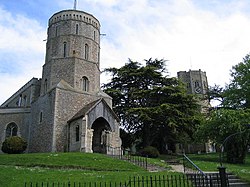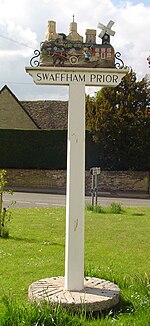Swaffham Prior
| Swaffham Prior | |
| Cambridgeshire | |
|---|---|

| |
| Location | |
| Grid reference: | TL567639 |
| Location: | 52°15’0"N, 0°18’0"E |
| Data | |
| Population: | 841 (2011) |
| Post town: | Cambridge |
| Postcode: | CB25 |
| Dialling code: | 01638 |
| Local Government | |
| Council: | East Cambridgeshire |
Swaffham Prior is a village in Cambridgeshire, at the fen-edge, five miles west of Newmarket. Its neighbour is Swaffham Bulbeck, and the two are collectively referred to as 'The Swaffhams'. The village of Burwell lies two miles northeast of Burwell.
Swaffham Prior was often known as 'Great Swaffham' in past centuries. The names of the Swaffhams are assumed to be of the same origin as that of the town of Swaffham in Norfolk; Swæfa ham, meaning "Home of Swabians", a Germanic tribe some of whom may have settled in Britain in the Dark Ages along with the Angles, Saxons and Jutes.
Contents
Churches
The village is dominated by its twin churches that have served the parish since at least the 12th century – the Church of St Mary, and the Church of St Cyriac and St Julitta (dedicated to Saint Quiricus and Saint Julietta). In 1667 a parliamentary order combined the churches under a single parish.
The church of St Mary was first built in Norman times, and over its history has at times been allowed to fall into ruin, only being fully restored at the start of the 20th century and now serving as the parish church. It contains an attractive rood screen, and is celebrated for its series of stained glass windows showing scenes from World War I.
The original church of St Cyriac and St Julitta (Cyriac's mother) was built prior to 1200, and may possibly have existed before 1066. The present chapel is a plain Gothic-style church, consisting of a small chancel and nave with three small transeptal chapels. The tower was built in the 15th century tower and contains 6 bells. Having fallen into disuse, in 1878 an order was received that the church be demolished, but the order was never carried out. It now serves as a hall for exhibitions and other functions. Scottish poet Edwin Muir (1887-1959) is buried here.
John George Witt, the well-known barrister and Q.C./K.C. of Victorian and Edwardian England, who was born in 1836 at Denny Abbey, Waterbeach, Cambridgeshire, was a son of James Maling Witt (1799 - 1870), a prosperous farmer at Waterbeach and at Queens' College Farm, Swaffham Prior. J.G. Witt lived at Swaffham Prior during much of his youth and early manhood. He died in London in 1906.
History
Swaffham Prior is an old village with rich and abundant history, even mentioned in the Domesday Book as possibly 'Great Swaffham', with Swaffham Bulbeck being 'Little Swaffham'. There are many houses in the village of great age dating back to all of the last few centuries, with the 17th century being most prominent. The village is and has always been one of trade and it has a history of trade down the centuries that continues to this day in different forms. Today it could be described as a 'dormitory' village especially looking back on its far busier past - but there is still a good community here with a great local primary school and The Red Lion pub, which many in the village consider the heart of the community today. There's also a picturesque Village Hall, also hosting many village get-togethers such as feasts, village fates etc.
Swaffham Prior is famous not only for its two churches which tower above the village and can be seen for miles around but also for its two windmills (one still operating as a mill) which have also long been part of village life and are iconic symbols of the village, seen on the village sign on Cage Hill.
Outside links
| ("Wikimedia Commons" has material about Swaffham Prior) |
- World War I commemorative stained glass
- A history of Swaffham Prior's churches
- The Swaffham Crier - Swaffham Prior's Village Magazine
- Swaffham Prior in A Vision of Britain
